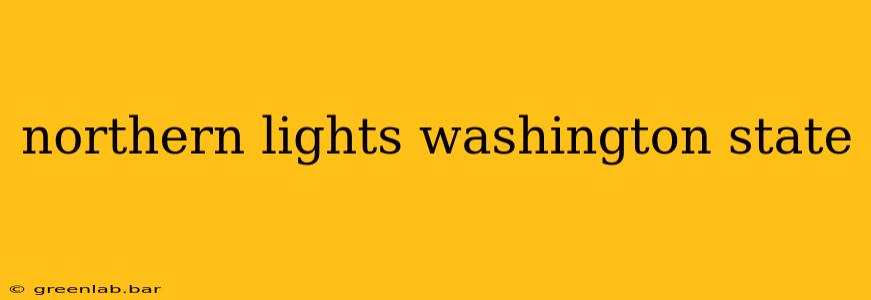Washington State, known for its stunning natural beauty, offers more than just majestic mountains and evergreen forests. While not as consistently visible as in Alaska or Canada, the Northern Lights, or Aurora Borealis, can sometimes grace the skies of Washington, creating a breathtaking spectacle. This guide will delve into the best times to see them, ideal viewing locations, and essential tips for maximizing your chances of witnessing this celestial event.
Understanding the Aurora Borealis in Washington
The Aurora Borealis occurs when charged particles from the sun collide with atoms in the Earth's atmosphere. This interaction releases energy in the form of light, creating the mesmerizing dancing curtains of green, sometimes purple or red, across the night sky. Washington's location, relatively far south of the auroral oval (the area where the aurora is most frequently visible), means sightings are less frequent and often fainter than in higher latitudes.
However, during periods of intense solar activity, known as geomagnetic storms, the auroral oval expands southward, increasing the chances of viewing the aurora even in Washington. This is why understanding solar activity forecasts is crucial for aurora hunting in the state.
When to See the Northern Lights in Washington
The best time to see the Northern Lights in Washington is during the winter months, from late September to early April. Several factors contribute to this:
- Longer Nights: The longer hours of darkness provide more opportunity to witness the aurora.
- Solar Activity: While solar activity is unpredictable, there's generally an increased chance of geomagnetic storms during these months.
- Clear Skies: Clear skies are essential for aurora viewing. Winter often brings clearer, drier conditions in many parts of the state.
However, even during these months, sightings are not guaranteed. Regularly checking space weather forecasts is essential for increasing your odds.
Where to See the Northern Lights in Washington
Finding locations with minimal light pollution is key for successful aurora viewing. Here are some of the best spots in Washington:
Dark Sky Locations:
- Eastern Washington: Eastern Washington offers significantly darker skies than the western part of the state due to less population density. Areas like the Palouse and the Okanogan-Wenatchee National Forest are excellent choices.
- North Cascades National Park: The remote areas of the North Cascades provide ideal darkness, but access can be limited in winter. Always check road conditions before heading out.
Specific Considerations:
- Elevation: Higher elevations often offer clearer skies and better viewing opportunities.
- Horizon View: Choose a location with an unobstructed view of the northern horizon.
- Distance from City Lights: The further away from city lights you are, the better your chances of seeing a faint aurora.
Tips for Maximizing Your Chances
- Check Space Weather Forecasts: Websites and apps dedicated to space weather provide real-time updates on solar activity and aurora predictions.
- Use a Dark Sky App: Apps like Dark Sky or Light Pollution Map can help you find areas with minimal light pollution.
- Be Patient: Aurora sightings can be unpredictable. Be prepared to spend several hours observing the sky.
- Dress Warmly: Winter nights in Washington can be extremely cold. Dress in layers to stay warm and comfortable.
- Bring Binoculars or a Telescope: These can enhance your viewing experience, especially for fainter auroras.
- Photograph the Aurora: If you're interested in capturing the aurora on camera, research nighttime photography techniques beforehand.
Conclusion
Witnessing the Northern Lights in Washington State is a truly magical experience. While not guaranteed, by following these tips and understanding the factors influencing aurora visibility, you can significantly increase your chances of seeing this breathtaking natural phenomenon. Remember to always prioritize safety and be prepared for potentially challenging weather conditions. Happy aurora hunting!

